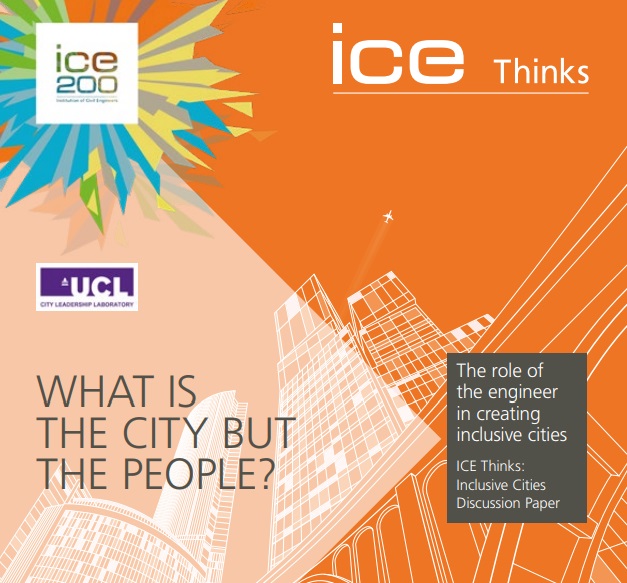The role of the engineer in creating inclusive cities
In April 2018, ICE Thinks published a discussion paper looking at how industry can make cities more inclusive.
The in-depth paper 'What is the city but the people? The role of the engineer in creating inclusive cities’ challenges industry and engineers to think harder about designing and building more inclusive cities.
The discussion paper focuses on issues such as the City at Night, the importance of the night-time economy and night workers; the Feminist City, how men and women use cities differently and how that can be incorporated from an engineering perspective; and the Accessible City, ensuring that people of all levels of mobility and accessibility requirements can use cities without issues.
This follows the Inclusive Cities conference in February 2017 where experts from across industry, policy, design, academia and the arts examined the role of the engineer in city planning and social sustainability.
In the paper, ICE issues three challenges to industry and academia about how they can help to create more inclusive cities in the future:
- Ensure greater female representation throughout the sector.
- Commission research on how infrastructure can better support the needs of night workers and the night-time economy.
- Engineers to think about design from the point of view of people with differing needs to their own.
ICE President Professor Lord Robert Mair said:
“Our citizens have vast and varied lifestyles and it is essential that our cities are able to work for them. Helping people live better, less complicated lives is at the very heart of engineering and we’re challenging the industry to do more to design and build cities that are inclusive for all, at all times, regardless of gender, mental or physical ability.
“As we celebrate ICE 200 it's apt that we not only recognise the important work of the past but consider what engineers can do for the future, helping build more inclusive communities and cities in the next 200 years.”
Dr Ellie Cosgrave, lecturer in urban design at City Leadership Lab UCL, adds:
“We want to lead our industry in debating how cities can be more inclusive. As well as value for money, we should be thinking about the social value of the things we build, and environmental and economic sustainability. Inclusivity is not a buzzword. How we design our cities impacts on people’s lives so we must ensure the infrastructure which our cities depend on is welcoming to all.”
You can download the paper here.
This article was originally published here by ICE on 25 April 2018. It was written by Emma Beer.
--The Institution of Civil Engineers
[edit] Related articles on Designing Buildings Wiki
- Articles by ICE on Designing Buildings Wiki.
- 2050 and the Future of Infrastructure.
- Access and inclusion in the built environment: policy and guidance.
- Balance for Better: Why lack of diversity is an issue for everyone.
- Capability Brown - proof that engineering for sustainability works.
- Designing smart cities.
- Engineer.
- How business can bridge the infrastructure gap.
- How to become a civil engineer.
- ICE online archives.
- Inclusive design.
- The role of civil engineering in designing out loneliness.
Featured articles and news
RTPI leader to become new CIOB Chief Executive Officer
Dr Victoria Hills MRTPI, FICE to take over after Caroline Gumble’s departure.
Social and affordable housing, a long term plan for delivery
The “Delivering a Decade of Renewal for Social and Affordable Housing” strategy sets out future path.
A change to adoptive architecture
Effects of global weather warming on architectural detailing, material choice and human interaction.
The proposed publicly owned and backed subsidiary of Homes England, to facilitate new homes.
How big is the problem and what can we do to mitigate the effects?
Overheating guidance and tools for building designers
A number of cool guides to help with the heat.
The UK's Modern Industrial Strategy: A 10 year plan
Previous consultation criticism, current key elements and general support with some persisting reservations.
Building Safety Regulator reforms
New roles, new staff and a new fast track service pave the way for a single construction regulator.
Architectural Technologist CPDs and Communications
CIAT CPD… and how you can do it!
Cooling centres and cool spaces
Managing extreme heat in cities by directing the public to places for heat stress relief and water sources.
Winter gardens: A brief history and warm variations
Extending the season with glass in different forms and terms.
Restoring Great Yarmouth's Winter Gardens
Transforming one of the least sustainable constructions imaginable.
Construction Skills Mission Board launch sector drive
Newly formed government and industry collaboration set strategy for recruiting an additional 100,000 construction workers a year.
New Architects Code comes into effect in September 2025
ARB Architects Code of Conduct and Practice available with ongoing consultation regarding guidance.
Welsh Skills Body (Medr) launches ambitious plan
The new skills body brings together funding and regulation of tertiary education and research for the devolved nation.
Paul Gandy FCIOB announced as next CIOB President
Former Tilbury Douglas CEO takes helm.
UK Infrastructure: A 10 Year Strategy. In brief with reactions
With the National Infrastructure and Service Transformation Authority (NISTA).
























